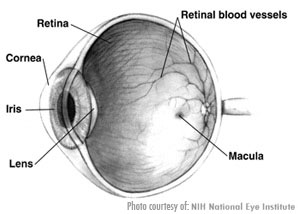From Exotic Particles to Possible Solutions for Blindness
10 June 2008 | By

The search for exotic particle has led Alan Litke and his ATLAS colleagues to design a system that has allowed the discovery of a new type of cell in the retina of primates, and this technology is helping to find solutions for certain types of blindness.
Litke and his team from the University of California, Santa Cruz, together with a group of neurobiologists at the Salk Institute in La Jolla, California, are studying how the retina processes and encodes the visual information of the outside world. "We started out developing instruments to look for top quarks and Higgs bosons. Then we realized we could apply some of those technological concepts to the study of biological neural systems, such as the retina," Litke says. The retina can be seen as a sophisticated pixel detector, which converts visual images captured by the photoreceptors into a set of highly processed electrical signals transmitted by the output neurons in the retina, known as ganglion cells, to the visual cortex and other areas in the brain. However, neurobiologists still need to fully understand the code used by the retina to convert visual images into electrical signals. Litke and his colleagues are trying to shed light on the process: "To study this code, we are developing an imaging system for large-scale neural activity to measure the response to light of a large number of ganglion cells."

The lack of information about the visual response properties of the 22 or more distinct types of ganglion cells in the retina has severely limited the understanding of vision in primates –and in humans. Each of this distinct types of cells encodes different aspects of the visual field, such as movement, spatial patterns or colour. So far, neurobiologists have only identified the functional properties of a small number of them.
ATLAS physicists, including Alex Grillo of UC Santa Cruz and Wladyslaw Dabrowski of the AGH University of Science and Technology in Krakow, have designed a new imaging system able to simultaneously measure the response to light of hundreds of retinal ganglion cells. Wladyslaw, an integrated circuit expert, and his team, have fabricated a special multichannel integrated circuit , which consists of 512 electrodes crammed into 1.7 square millimetres, known as the 'Neurochip'. Up to now, the state-of-the-art technology only allowed studying tens of ganglion cells at a time, which made it extremely difficult to identify common patterns in the response of cells to light.
In the experiments with the 'Neurochip', the electrical activity of more than 250 ganglion cells was simultaneously recorded as a visual image and focused on the photoreceptors. The technique has already borne fruit: the discovery of a new functional type of ganglion cell, known as the upsilon cell, which is believed to contribute to motion perception in primates. The findings were published in the prestigious Journal of Neuroscience in October 2007. Thanks to the new system developed by ATLAS scientists, neurobiologists have now a new tool to identify the functional properties of each type of ganglion cell in the retina. With this information at hand, it should be possible to design a range of prosthetic devices in the future: "If you can mimic the process that transforms images into electrical signals, then codifying the visual information to the brain with some devices becomes possible in principle" explains Litke.
The prosthesis would consist of a dense array of small electrodes that would stimulate individual ganglion cells, which would send out the right information to the brain.
These devices would benefit people affected by certain types of eye diseases causing blindness, such as macular degeneration and retinitis pigmentosa, in which photoreceptors degenerate but ganglion cells are unaffected.
The contribution of Alan and his group to neurobiology is a success story of how the expertise gained through particle physics can push discovery in other scientific fields: "We can bring new ways of looking at things," Alan says. Thus, particle physics not only enables exploration of the innermost secrets of matter and energy, but is also furthering exploration of one of the rather unknown parts of the human body: "Understanding the retina is a contribution to understanding the workings of brain."



